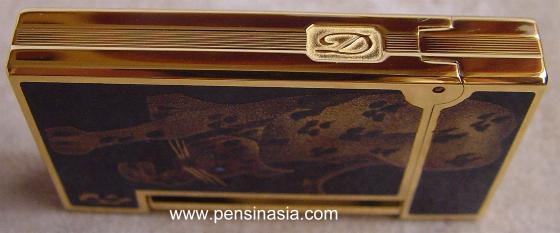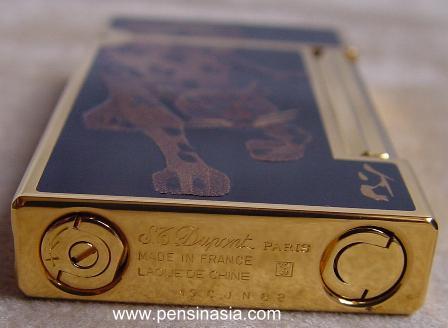

S.T.
DUPONT MAKI-E PANTHER LIGHTER
LIMITED
SERIES
LACQUERS
The
first use of lacquer is lost in the mists of time. However we do know that
in the second Millennium BC, there was mention of a painted Lacquered screen
and a sort of tambourin which dated from the time of the emperor YU.
Whether
the lacquer was painted, inlaid sculpted (Tiao Tsi), gold embossed (Ts'iang
Kin), engraved, inlaid eggshell or mother of pearl, coromandel or Ke-Hui,
the variety of techniques used in the orient was infinite, and the only
thing the craftsmen had in common was the sap they used.


The art
of lacquering reached its peak in China in the XVIII century, under the Ming
Dynasty, and its influence extended as far as Europe. But although the
technique was undoubtedly invented in China, it was the Japanese, initiated
by Chinese artists, who developed the technique of lacquer to its most
perfect level, becoming the absolute art of Japan during the XVIII-XIX
Centuries.
The art
of lacquering can be taught, but above all, it is learned. It is much more
than a technique, demanding both patience and skill.
Each
lacquer has a life of its own, its fickleness and intractability are
discovered, day after day, year after year.
No two
lacquers are ever alike, no two craftsman ever work in the same way.



LACQUER
The raw
material itself changes with time. It is more or less docile, more or less
fluid, depending on the season, the age of the tree and its origin.
The
resinous sap of Rhus Vemicifera is collected during five months in small
bamboo buckets. When it comes into contact with the air, it darkens slightly
and takes on the consistency of Latex.
Conserved
in a humid dust-free atmosphere, it separates into different layers, of
which the best, the top one ("son-mal-giau" in Chinese), will be
used for the final coating of lacquer.
At this
stage the preparation of the lacquer begins. The craftsmen are extremely
discreet about which additives they use, whether it is Tong Yeau oil, iron
sulphate or rice vinegar. The mystery is even deeper when it comes to
colouring.
A host
of ingredients are used : wood oils and all sorts of cinnabarite powders
whose names evoke the art of the apothecary or the alchemist.


Lighter is New
Lighter is new and never been
used. Comes with original box and paper as shown above. I accept
money order, bank draft, credit card or even wire. Conditions apply for
credit card.


